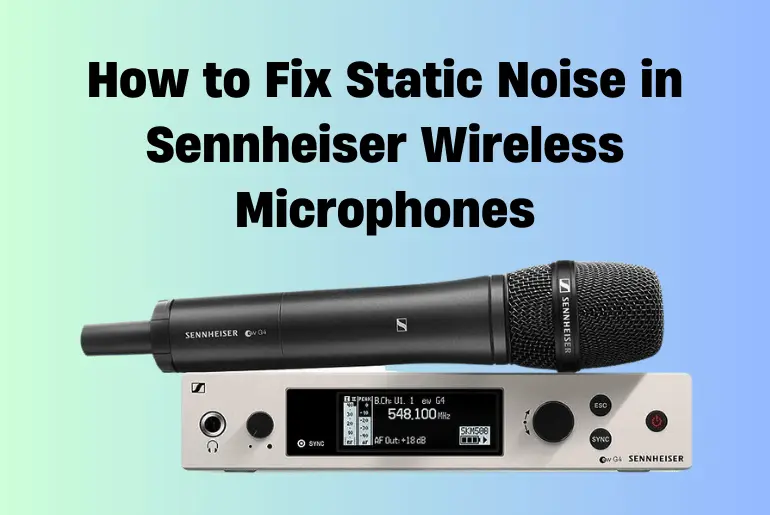Sennheiser, a revered name in the world of audio equipment, offers an expansive range of high-quality wireless microphones. Like all sophisticated electronics, users might occasionally encounter issues such as static noise interference.
Whether you’re a professional sound engineer, an event manager, or someone using the microphone for personal endeavors, experiencing static noise can impede the clear transmission of sound, defeating the very purpose of the microphone. This post will provide step-by-step procedures on how to tackle and rectify static noise in Sennheiser wireless microphones.
Post Contents
What Causes Static Static Noise in Sennheiser Wireless Microphones
1. Interference from other devices
Wireless microphones, including those from Sennheiser, operate on specific radio frequencies. Interference can arise if other electronic devices (like routers, other wireless microphones, or broadcasting equipment) are operating on or near the same frequency.
2. Low battery power
When a wireless microphone or receiver’s battery power starts to wane, it can lead to reduced signal strength and potential static interference. Always ensure that the batteries are sufficiently charged or fresh.
3. Faulty or damaged cables
Even though the microphone is wireless, there are still cables involved in the connection between the receiver and the sound system. A damaged or compromised cable can introduce static noise into the system.
4. Environmental factors
Elements such as thick walls, metal objects, or electronic equipment between the transmitter (microphone) and the receiver can obstruct or weaken the signal, leading to static noise. It’s crucial to ensure a clear line of sight, or at least an environment with minimal obstructions, between these two components.
5. Internal component malfunction
Sometimes, the static noise might be due to a malfunctioning internal component of the microphone or receiver. This could be the result of wear and tear, manufacturing defects, or exposure to elements like moisture or excessive heat.
How to Fix Sennheiser EW100 G3’s Noise Problem
1. Frequency interference
The ew100 G3 operates on UHF frequencies, which can be crowded with various devices. Scan and set the microphone and receiver to an unoccupied frequency. Use the “Easy Setup” function on your receiver to scan for available frequencies. Once the scan completes, synchronize the microphone to the new frequency by using the infrared interface.
Try to avoid placing the system near other electronic equipment that might interfere, such as routers or broadcast systems.
2. Battery levels
Both the transmitter (microphone) and receiver have a battery status indicator. If the battery is low, especially on the transmitter, it can lead to noise problems. Always use high-quality batteries, and replace or recharge them when they indicate low levels.
3. Cables and connections
Check the connection cables between the receiver and the sound system. Ensure they are firmly connected, free from visible damage, and not excessively coiled or tangled. If you suspect a faulty cable, replace it with a known working cable to see if the noise problem is resolved.
4. Squelch settings
The squelch function controls the threshold at which the receiver mutes the output to prevent weak signal transmissions, which can lead to static noise. Access the ‘Squelch’ setting in the menu, and if it’s set too low, increase the setting until the static noise disappears. Be cautious not to set it too high, as it might cut out the desired signal.
5. Environmental and structural considerations
Ensure there is as little obstruction as possible between the transmitter and receiver. Metal objects, thick walls, and other electronic devices can interfere with the signal. If you’re in a multi-microphone setting, maintain a minimum distance between each microphone to avoid crosstalk or interference.
Consider using external antennas or antenna distribution systems for enhanced reception, especially in environments with multiple barriers or significant distances between devices.
FAQ
What is squelch setting Sennheiser?
The squelch setting in Sennheiser wireless systems, including the ew100 G3, serves as a safeguard against unwanted static or noise when the transmitters are turned off. Essentially, squelch acts as a threshold control, muting the audio output when the signal strength drops below a certain level. This ensures that in the absence of a strong and clear transmission from the microphone, the system won’t produce any static noise.
Conclusion
Troubleshooting static noise in Sennheiser wireless microphones may seem like a daunting task initially, but with a systematic approach, one can easily identify and rectify the source of the interference. Remember, like all technological tools, regular maintenance and periodic checks are essential for optimum performance.
If the static persists after following the aforementioned steps, it might be time to consult a professional or reach out to Sennheiser’s support. Never compromise on sound quality, especially when you have the tools and knowledge to ensure its perfection.

